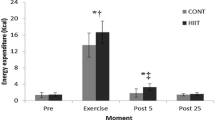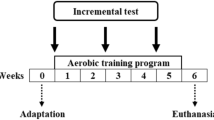Summary
The rats were made to run daily to exhaustion, for 28 days at a speed of 1,200 m·h−1 on a treadmill set at a gradient of + 10°. The training increased the time of running to exhaustion [184 (SD 49) and 308 (SD 28) min on the 1st and 28th day, respectively; P<0.001]. The body mass was reduced by training [257 (SD 21) g before and 221 (SD 20) g after; P<0.001] whereas the food intake increased [9 (SD 1) g·100 g− body mass before and 14 (SD 2) g after; P0.001]. The heart mass was not affected by training. Training increased the resting glycogen concentration in muscles composed of different fibre types (soleus, white and red vastus muscles) and in the liver, but had no effect on its concentration in the heart and diaphragm. During exercise lasting for 30 min glycogen mobilization in the red vastus and soleus muscles and the liver was more pronounced after than before training. A “sparing” effect of training on the skeletal muscles and liver glycogen was markedly apparent only after exericse to exhaustion. The trained rats, contrary to the untrained, did not develop hypoglycaemia during exercise to exhaustion. An increase in the plasma free fatty acid concentration during exercise after training was delayed and attenuated compared to that before training. The 24-h excretion of urea after exercise to exhaustion on the 28th day of training was higher than on the 1st day by 39% (P<0.001). It is concluded that metabolic adaptation to training consisting of daily bouts of exercise to exhaustion differs in many aspects from that so far described for other endurance training protocols.
Similar content being viewed by others
References
Angielski S (1985) Clinical biochemistry and analytics. Państwowy Zaklad Wydawnictw Lekarskich, Warsaw
Astrand PO, Rodahl K (1977) Textbook of work physiology. Physiological bases of exercise. McGraw-Hill, New York
Baldwin KM, Fitts RH, Booth FW, Winder WW, Holloszy JO (1975) Depletion of muscle and liver glycogen during exercise. Protective effect of training. Pfügers Arch 354:203–212
Bukowiecki L, Lupien J, Follea N, Paradis A, Richard D, LeBlanc J (1980) Mechanism of enhanced lipolysis in adipose tissue of exercise-trained rats. Am J Physiol 239 (Endocrinol Metab 2): E422-E429
Carlson LA (1963) Determination of serum triglycerides. J Atheroscler Res 3:334–336
Carroll NY, Longley RW, Roe JH (1956) The determination of glycogen in liver and muscle by use of anthrone reagent. J Biol Chem 220:583–593
Crews EL III, Fuge KW, Oscai LB, Holloszy JO, Shank RE (1969) Weight, food intake, and body composition: effect of exercise and protein deficiency. Am J Physiol 216:359–363
Dohm GL, Louis TM (1978) Changes in androstenedione and protein metabolism as a result of exercise. Proc Soc Exp Biol Med 158:622–625
Dohm GL, Hecker AL, Brown WE, Klein GJ, Puente FR, Askew EW, Becker GR (1977) Adaptation of protein metabolism to endurance training. Increased amino acid oxidation in response to training. Biochem J 164:705–708
Dohm GL, Williams RT, Kasperek GJ, van Rij AM (1982) Increased excretion of urea and NT-methylhistidine by rats and humans after about of exercise. J Appl Physiol Respir Environ Exerc Physiol 52: 27–33
Duncombe WG (1964) The colorimetric micro-determination of nonesterified fatty acids in plasma. Clin Chim Acta 9:122–125
Galbo H, (1983) Hormonal and metabolic adaptation to exercise. Thieme, Stuttgart
Galbo H, Richter EA, Holst JJ, Christensen NJ (1977) Diminished hormonal responses to exercise in trained rats. J Appl Physiol Respir Environ Exerc Physiol 43:953–958
Galletti F (1967) An improved colorimetric micromethod for the determination of serum glicerides. Clin Chim Acta 15:184–186
Górski J (1992) Muscle triglyceride metabolism during exercise. Can J Physiol Pharmacol 70:123–131
Górski J, Nowacka M, Namiot Z, Puch U (1988) Effect of prolonged exercise on the level of triglycerides in the rat liver. Eur J Appl Physiol 57:554–557
Górski J, Oscai LB, Palmer WK (1990) Hepatic lipid metabolism in exercise and training. Med Sci Sports Exerc 22:213–221
Harpur RP (1980) The rat as a model for physical fitness studies. Comp Biochem Physiol 66A:553–574
Hickson RC, Rennie MJ, Coulee RK, Winder WW, Holloszy JO (1977) Effect of increased plasma fatty acids on glycogen utilization and endurance. J Appl Physiol 43:829–833
Hickson RC, Hammons GT, Holloszy JO (1979) Development and regression of exercise-induced cardiac hypertrophy in rats. Am J Physiol 236: 14268–14272
Holloszy JO, Coyle EF (1984) Adaptation of skeletal muscles to endurance exercise and their metabolic consequences. J Appl Physiol Respir Environ Exerc Physiol 56:831–838
Hurley BF, Nemeth PM, Martin WH III, Hagberg JM, Dalsky GP, Holloszy JO (1986) Muscle triglyceride utilization during exercise: effect of training. J Appl Physiol 60:562–567
Jansson E, Kaijser L (1987) Substrate utilization and enzymes in skeletal muscle of extremely endurance-trained men. J Appl Physiol 62:999–1005
Kuipers J, Keizer HA (1988) Overtraining in elite athletes. Review and directions for the future. Sports Med 6:79–92
Lemon PWR (1987) Protein and exercise: update 1987. Med Sci Sports Exerc 19:S179-S190
O'Brien DW (1981) The effect of prolonged physical training and high fat diet on heart size and body weight in rats. Can J Physiol Pharmacol 59:268–272
Oscai LB, Babirak SP, McGarr JA, Spirakis CN (1974) Effect of exercise on adipose tissue cellularity. Fed Proc 33:1956–1958
Oscai LB, Babirak SP, Dubach FB, McGarr JA, Spiraks CN (1977) Exercise or food restriction effect in adipose tissue cellularity. Am J Physiol 227:901–904
Ostrowski W (1971) Methods in clinical chemistry. Państwowy Zakład Wydawnictw Lekarskich, Warsaw
Peles AE, White TP III, Block WD (1985) Effect of exercise training on plasma lipids and lipoproteins in rats. J Appl Physiol 58: 612–618
Scheuer J, Tipton CM (1977) Cardiovascular adaptations to physical training. Am Rev Physiol 39:221–251
Stallknecht B, Kraer M, Mikines J, Maroun L, Ploug T, Ohkuwa T, Vinten J, Galbo H (1990) Diminished epinephrine response to hypoglycemia despite enlarged adrenal medulla in trained rats. Am J Physiol 259[Regulatory Integrative Comp Physiol 28] R998-R1003
Stevenson JAF, Box BM, Feleki V, Beaton JR (1966) Bouts of exercise and food intake in the rat. J Appl Physiol 21:118–122
Tan EM, Hanson ME, Richter CP (1954) Swimming time of rats with relation to water temperature. Fed Proc 13:150–156
Thomas BM, Miller AT Jr (1958) Adaptation to forced exercise in the rat. Am J Physiol 193:350–354
Author information
Authors and Affiliations
Rights and permissions
About this article
Cite this article
Zendzian-Piotrowska, M., Górski, J. Metabolic adaptation to daily exercise of moderate intensity to exhaustion in the rat. Europ. J. Appl. Physiol. 67, 77–82 (1993). https://doi.org/10.1007/BF00377709
Accepted:
Issue Date:
DOI: https://doi.org/10.1007/BF00377709




